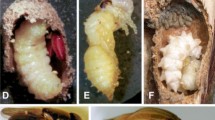Abstract
Varroa jacobsoni reproduces in honey bee brood cells. Here the behavioral activity and use of space by infestingVarroa females and progeny were quantified in transparent artificial brood cells. The time-activity budget of both infesting and developing mites converged toward a stable pattern which was established during the bee prepupal stage of the infesting mites and the protonymphal stage of mite progeny. The pattern was such that infesting females and offspring eventually divided their activity between the fecal accumulation on the cell wall, which served as the rendezvous site for newly molted individuals, and the feeding site prepared on the pupa by the foundress. Other parts of the cell wall were used for oviposition and molting, away from the fecal accumulation on which activity of mobile stages was concentrated. Space structuring and the time-activity budget inVarroa probably evolved to enhance the number of fertilized females produced within the capped brood, where space and time are limiting factors. These behavioral adaptations parallel those of other mite species which show group behavior within cavities.
Similar content being viewed by others
References
Akimov, I. A., Pileckaja, I. P., and Yastrebtsov, A. V. (1990). Der Reproduktionszyklus der MilbeVarroa jacobsoni und ihre Beziehung zum Wirt.Vestnik Zool. 2: 41–46 (translated from Russian).
Blaney, W. M., Schoonhoven, L. M., and Simmonds, M. S. J. (1986). Sensitivity variations in insect chemoreceptors: A review.Experientia 42: 13–19.
Buskirk, R. E. (1981). Sociality in the Arachnida. In Hermann, H. R. (ed.),Social Insects, Vol. II, Academic Press, New York, London, Toronto, Sydney, San Francisco, pp. 281–367.
Dade, H. A. (1962).Anatomy and Dissection of the Honey Bee, Bee Research Association (IBRA), London.
Donzé, G. (1995).Behavioural Attributes of the Parasitic Mite Varroa jacobsoniDuring its Reproductive Phase in the Brood of the Honey Bee Apis mellifera, Ph.D. dissertation, University of Neuch{ie392-1}tel, Neuch{ie392-2}tel.
Donzé, G., and Guerin, P. M. (1994). Behavioral attributes and parental care ofVarroa mites parasitizing honeybee brood.Behav. Ecol. Sociobiol. 34: 305–319.
Donzé, G., Herrmann, M., Bachofen, B., and Guerin, P. M. (1996). Effect of mating frequency and brood cell infestation rate on the reproductive success of the honey bee parasiteVarroa jacobsoni.Ecol. Entomol. 21: 17–26.
Frey, D. F., and Pimental, R. A. (1978). Principal component analysis and factor analysis. In Colgan, P. W. (ed.),Quantitative Ethology, John Wiley, New York, pp. 219–245.
Fuchs, S., and Langenbach, K. (1989). Multiple infestation ofApis mellifera L. brood cells and reproduction inVarroa jacobsoni Oud.Apidologie 20: 257–266.
Infantidis, M. D. (1983). Ontogenesis of the miteVarroa jacobsoni in worker and drone honeybee brood cells.J. Apicult. Res. 23: 200–206.
Jay, S. C. (1962). Prepupal and pupal ecdyses of the honeybee.J. Apicult. Res. 1: 14–18.
Jay, S. C. (1964). The cocoon of the honeybeeApis mellifera L.Can. Entomol. 96: 784–792.
Klowden, M. J. (1990). The endogenous regulation of mosquito reproductive behavior.Experientia 46: 660–670.
Le Conte, Y., Arnold, G., Trouiller, J., Masson, C., Chappe, B., and Ourisson, G. (1989). Attraction of the parasitic miteVarroa to the drone larvae of honeybees by simple aliphatic esters.Science 245: 638–639.
Martin, S. J. (1995). Ontogenesis of the miteVarroa jacobsoni Oud. in drone brood of the honeybeeApis mellifera L. under natural conditions.Exp. Appl. Acarol. 19: 199–210.
Michener, Ch. D. (1974).The Social Behavior of the Bees. A Comparative Study, Belknap Press, Harvard University Press, Cambridge, MA.
Noldus, L. P. J. J. (1991). The observer: A software system for collection and analysis of observational data.Behav. Res. Methods Instrum. Comput. 23: 415–429.
Rehm, S. M., and Ritter, W. (1989). Sequence of the sexes in the offspring inVarroa jacobsoni and the resulting consequences for the calculation of the developmental period.Apidologie 20: 339–343.
Rickli, M., Guerin, P. M., and Diehl, P. A. (1992). Palmitic acid released from honeybee worker larvae attracts the parasitic miteVarroa jacobsoni on a servosphere.Naturwissenschaften 79: 320–322.
Rickli, M., Diehl, P. A., and Guerin, P. M. (1994). Cuticle alkanes of honeybee larvae mediate arrestment of bee parasiteVarroa jacobsoni.J. Chem. Ecol. 20: 2437–2453.
Rosenkranz, P. (1990).Wirtsfaktoren in der Steuerung der Reproduktion der parasitischen Bienenmilbe Varroa jacobsoniin Völker von Apis mellifera, Ph.D. dissertation, University Tübingen, Tübingen.
Saitò, Y. (1983). The concept of “life types” in Tetranychinae. An attempt to classify the spinning behavior of Tetranychinae.Acarologia 24: 377–391.
Saitò, Y. (1986). Biparental defence in a spider mite (Acari: Tetranychidae) infesting Sasa bamboo.Behav. Ecol. Sociobiol. 18: 377–386.
Saitò, Y. (1997). Sociality and kin selection in Acari. In Choe, J. C., and Crespi, B. (eds.),The Evolution of Social Behavior in Insects and Arachnids, Cambridge University Press, New York.
Scott, M. P., and Traniello, J. F. A. (1987). Behavioral cues trigger ovarian development in the burying beetle,Nicrophorus tomentosus.J. INsect Physiol. 33: 693–696.
Steiner, J., Dittman, F., Rosenkranz, P., and Engels, W. (1994). The first gonocycle of the parasite mite (Varroa jacobsoni) in relation to preimaginal development of its host, the honey bee (Apis mellifera carnica).Invert. Reprod. Dev. 25: 175–183.
Treat, A. E. (1975).Mites of Moths and Butterflies, Cornell University Press, Ithaca, NY.
Trouiller, J., Arnold, G., Chappe, B., Le Conte, Y., and Masson, C. (1992). Semiochemical basis of infestation of honey bee brood byVarroa jacobsoni.J. Chem. Ecol. 18: 2041–2053.
Tukey, J. W. (1977).Exploratory Data Analysis, Addison-Wesley, Reading, MA.
Wilkinson, L. (1990).Sygraph: The System for Graphics, Systat Inc., Evanston, IL.
Author information
Authors and Affiliations
Rights and permissions
About this article
Cite this article
Donzé, G., Guerin, P.M. Time-activity budgets and space structuring by the different life stages ofVarroa jacobsoni in capped brood of the honey bee,Apis mellifera . J Insect Behav 10, 371–393 (1997). https://doi.org/10.1007/BF02765605
Issue Date:
DOI: https://doi.org/10.1007/BF02765605




